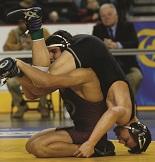
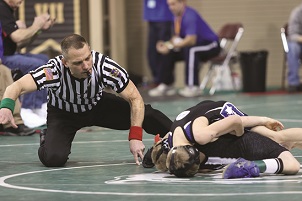
Combative sports might require a bit of extra planning and effort, but going that extra mile can certainly pay off. These sports represent not only some of the fastest-growing sports in America, but also they have the potential to draw large numbers of athletes as well as participants.
Ancient Combat, Modern World
After being removed, albeit briefly, from the Olympic sport roster, wrestling is reasserting its dominance, and regaining popularity, with some organizational and on-the-mat changes. United World Wrestling, the sport’s international governing body (formerly known as FILA), recently adapted some of the weight classes, opened up the possibility of Greco-Roman wrestling for women, and adapted scoring to encourage more dynamic, aggressive matches.
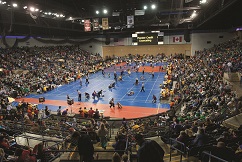
“Randy Lewis won the gold medal at the 1984 L.A. Olympics, and he’s from Rapid City. That inspired a steady stream of wrestling success in our community over the course of the last 20 or 30 years,” says Domico, Rodriguez, director of sports and event. “The reason we’ve remained a kind of a hotbed of wrestling is that we have a very good local youth program and competitive teams in all age groups. Being competitive and successful gets people involved, and that is the key to success with wrestling events.”
Successful wrestling events also require being able to deliver on some unique challenges and needs, says Chris Willaert, who is president of the Mankato Area Youth Wrestling Club, director of the Mankato Sports Commission and former youth director for Minnesota USA Wrestling.
“The biggest issue with creating or bringing big events here to Mankato has been facilities. We can accommodate a tournament for 300 to 600 kids, but we haven’t been able to crack into the 1,000-plus competitor event group, which requires a lot of mats,” says Willaert. He’s working on some options for new facilities, but he says that even with a venue that can hold enough mats, other challenges exist.
“Sanctioning through USA Wrestling is important because it means the event organizer doesn’t have to buy separate insurance, which is required,” says Willaert. “One of the other big challenges is getting enough mats. You need strong connections within the community to bring together enough mats for a big event.”
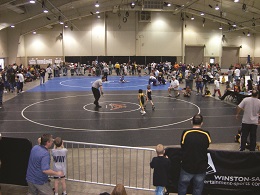
Mats aren’t the only challenge specific to wrestling, however. “The second-biggest challenge is getting competent people to volunteer. You need three people per table for each mat to be sure that everything is scored correctly and that the mat is equipped correctly. If you have 15 mats, you need 45 people who are experienced and knowledgeable about wrestling,” says Dresser.
You have the best chance of tapping into a rich source of experienced, knowledgeable wrestling volunteers in a community with a rich wrestling heritage, and Oklahoma is one of those places, having produced 12 Olympic gold medalists since 1932, as well as continual college and high school wrestling teams.
It’s no surprise, then, that the state is home to some of the sport’s more preeminent events. For the USA Wrestling Girls Folkstyle Nationals and Junior Women’s Folkstyle National Duals, the sport’s NGB turns to Archie Randall, head wrestling coach at Oklahoma City University, to direct the event.
“Coach Randall has grown the event so much that they are getting too big for the facility on the OCU campus and will probably need to move,” says Jennifer Breedlove, sports business development manager, Oklahoma City Convention and Visitors Bureau.
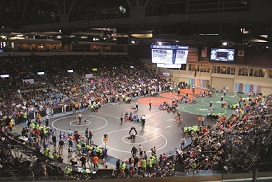
Another state with a strong wrestling background is North Carolina. This year, North Carolina USA Wrestling presented the 33rd annual Middle School State Wrestling Championships and the 15th annual Elementary School State Wrestling Championships at the W-S Fairgrounds and Education Building in Winston-Salem. These two events drew more than 2,800 people and delivered nearly a $500,000 impact to the Winston-Salem economy.
“Winston-Salem is an affordable destination with exciting activities to take part in even outside the sporting events,” says Bonny Bernat, sports and events sales manager for Visit Winston-Salem. “With more than 4,800 hotel rooms Winston-Salem offers a variety of conveniently located accommodations for athletes and spectators, and with $1.2 billion recently invested, Winston-Salem’s nationally-ranked downtown has become a hotspot for business, retail and more than 100 locally-owned restaurants and eateries.”
But, say sports tourism professionals in Pennsylvania, a great event also depends largely on having an experienced partner. The Pennsylvania Junior Wrestling Championships returned to the Erie Insurance Arena this year, where the community has a not-so-secret weapon for wrestling success.
“We rely on a veteran wrestling event organizer, Don Pallard, who has done multiple different highly successful tournaments,” says Mark Jeanneret, events director, Erie Sports Commission. “He has all the connections and puts out any fires.”
It’s a formula that works, creating an event that drew more than 5,000 spectators and 980 wrestlers ages 8 to 12.
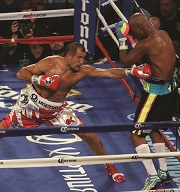
Wrestling might be the oldest combative sport, but it’s not the only one. A number of other combative sports are showing strong growth in both participation as well as spectators. Boxing also has ancient roots, but it too has a passionate modern following, demonstrated by the well-publicized fact that at-home viewers paid $100 to watch the recent Mayweather vs. Pacquiao fight.
Amateur boxers can begin competing at the age of eight, and the events are sanctioned by USA Boxing, the sport’s national governing body. When young children are involved in hand-to-hand combat, though, emotions can run high, creating a particular challenge for boxing event planners: parents.
“One tricky thing about youth boxing events is security,” says Brandon Dyett, director of events, USA Boxing. “I used to run recreational sports and I’ve seen parents get rowdy. But when you’re doing combative sports, they tend to ramp up the rowdiness.”
Boxing judges score the matches based on a specific points system, Dyett explains, which can create confusion and, in some cases, anger among spectators. “Parent might be seeing their kid throwing a lot of punches, and so they think their kid is surely winning. But if those punches aren’t landing, the kid isn’t earning points. When the score card comes up, it can be a big deal.”
To ensure a successful combative event, says LaTisha Brice, manager, Duncanville Fieldhouse, adequate set-up time is imperative and usually requires extended assembly. She suggests “the time-consuming task of mat set-up be done the night before, along with weigh-ins, to ensure a timely event.”
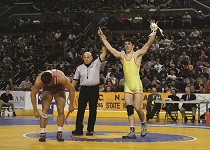
“We request help from local [organizing] committees for ambulances,” says Dyett. “EMT services and local fire stations will sometimes volunteer, but it can be harder to coordinate and costly in some cases.”
The issue of ambulances can be a crucial planning consideration for mixed martial arts events, says Jon Frank, head of the promoters advisory committee for the United States Fight League (USFL), a regulatory and sanctioning organization that supports Pankration, Grappling and Modified Mixed Martial Arts.
“Currently, our events for youth are only legal in California, so when considering logistical things like medical support, we look for affordability. Each different county in California has a different rate for ambulances, and they can vary greatly,” says Frank.
Although California has the corner on the youth MMA market for now, that could change soon, as Frank and his team are working to correct what they see as misperceptions about the sport.
“Adult MMA works on the premise of damaging and punishing your opponent, but we created special rules for youth MMA,” says Frank. The focus in not on damage. It’s on executing proper technique, and we’ve removed most of the potentially dangerous moves like striking to the head.”
Frank’s own children were MMA fighters, and he and the United States Fight League actually developed this technique-driven version of MMA as a training program for pre-deployment Marines who need intense physical training but cannot risk serious injury.
As states consider whether to allow youth MMA fighting, a decision made by each state’s boxing commission, the question becomes: why even take the risk with kids? Frank argues that their organization’s rules protect children and the sport is actually beneficial in more ways than just the physical.
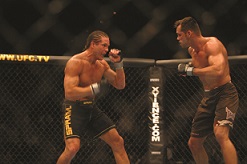 “The assumption is that MMA makes kids into bullies, but to be successful in our sport, with our rules, you have to have empathy and control,” says Frank. The USFL is also currently conducting a study of all its 130 licensed fighters, and preliminary results have revealed results that might change some minds about youth MMA: their athletes perform better academically than their non-combative peers.
“The assumption is that MMA makes kids into bullies, but to be successful in our sport, with our rules, you have to have empathy and control,” says Frank. The USFL is also currently conducting a study of all its 130 licensed fighters, and preliminary results have revealed results that might change some minds about youth MMA: their athletes perform better academically than their non-combative peers.
Some of combative sports’ highest profile events, such as the Action Martial Arts Expo at the Tropicana, call Atlantic City home, where they find the support they need to draw big names and crowds.
“We partner with properties to subsidize the purse and provide seed money for the event that is used towards marketing,” says James Wood, president and CEO, Visit Atlantic City. “Most important is our historic Boardwalk Hall that can host up to 14,000 people. Every up and coming promoter, or even existing promoter, is very interested in having their next fight in Boardwalk Hall.”
Indeed, for those looking for a classic venue, the 86-year-old Boardwalk Hall is a place to make history. In 1930, it hosted America’s first indoor college football game, and it has recently dazzled fans with events that run the combative sports spectrum, including the Kolvalev vs. Hopkins Boxing Match, the New Jersey State Interscholastic Athletic Association Wrestling Tournament and numerous UFC bouts.
Atlantic City itself sees the tide changing; Meet AC recently reported a number of positive economic indicators for the area, such as increases in hotel occupancy and casino revenue. The area continues to move away from its gambling town reputation and reach for new markets, including sports, leading to the formation of the Atlantic City Sports Commission.

